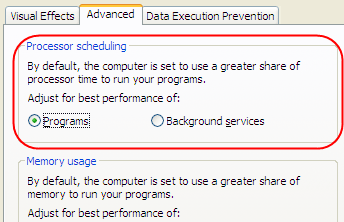There's a couple of different things to consider here:
When you change the priority of a process, that base priority is inherited by all it's threads, and other processes it starts. The current priority is made up from the base priority and a number of factors which determine whether it should be boosted or not - being in the foreground does not itself necessarily boost priority, but things like coming out of a wait state or doing some IO can give a short temporary boost.
I would suggest that running your Excel process with a high priority when working on these very intensive workbooks might make sense, and I would say a second shortcut called "High priority Excel" might be a good way to do this.
First make a one line batch file which runs the start command with appropriate switches, eg:
start "high priority excel" /max /high "C:\Program Files\Microsoft Office\Office12\EXCEL.EXE"
(on a 64 bit version of Windows this would be start "high priority excel" /max /high "C:\Program Files (x86)\Microsoft Office\Office12\EXCEL.EXE" unless you are also running a 64 bit version of Office, which is only available for 2010 onwards start "high priority excel" /max /high "C:\Program Files\Microsoft Office\Office14\EXCEL.EXE")
Note that the title for the window can be anything you like, but is not optional.
Now save this as eg HiperExcel.cmd somewhere handy - maybe the office folder, or a c:\scripts folder or somesuch, or your home folder so this can roam form machine to machine.
Create a new shortcut which points to this file, make the start folder the folder where the file is kept. Choose an icon for the file - browse to the Excel.exe executable then choose something other than the usual Excel icon for clarity.
Click your new shortcut and it will invoke Excel running as a high priority process, with a base priority of 13 and when running it will probably get the maximum priority for non-real-time processes of 15. Even if something else gets a boost, it should not get higher priority. Note that the foreground process does NOT get a boost of priority just for being in the foreground (not since NT4.0). So what is going on?
Re-cap what we know so far: Processes get to take turns according to priority, but not to the absolute exclusion of lower-priority processes (well, threads really, but lets keep things to processes for ease of discussion).
What happens when a process gets its "turn"? It gets to run for a unit of time called a quantum. How long is a quantum? It depends...
This is where the foreground process gets to use more of the resources - when it does get a turn, that turn can last three times longer than the turns of the background processes. So it might not get a go very often (depending on priority) but when it does, it hogs it for longer.
You can choose to use short or long quantums (default is short on workstation OS, long on servers), and to have the foreground process boosted or not (variable for w/s, fixed for servers by default), and if boosted, by how much (effectively up to 3 times).
Now, the tricksy part of this is that if you choose to change the multiplier, you end up with everything having very short values for quantum, whereas if you disable foreground boosting everything gets a longer but equal amount. If you disable it of course, background windows services get the same quantum as your user applications, which might not be ideal.
You need to set the value in the registry at: HKLM\System\CurrentControlSet\Control\PriorityControl\Win32PrioritySeparation, using a bit mask. To make things easier, the most likely values you would want are:
2 = default value, means use defaults with maximum boost. defaults on workstation O/S are short and variable.
8 = fixed, short quantum (foreground and background are equal)
40 (decimal, x28 hex) = fixed and long (this is the same as server defaults)
36 (decimal, x24 hex) = short, variable but minimal boosting for foreground process. I think this is the one which will probably give you the most benefit to reduce the amount that other apps compete, but allow Excel to get more resource when in the foreground (as long as you also raise its priority).
Try it and see, I hope this helps - your mileage may vary of course.
Aside:
Lots of other applications or processes do not have the CPU as their bottleneck - your examples of Outlook synching and IE browsing probably have the network, and possibly for Outlook some disk IO as more important factors in their speed, so whether they get a foreground boost or not, the impact in visible performance is probably below what you can see by simple observation.

Thread priority by itself has no effect on performance unless there are several threads competing for a resource - in which case, the higher priority gets first slice of the pie. I haven't used Excel for a long time, but it may be throttling itself when in the background, or you may be falling victim to Windows' somewhat retarded swapping mechanics. – Mark K Cowan – 2014-08-11T11:35:34.600
This happens with all Office 2007 programs when running long VBA scripts. I once wrote a script that took excel data and placed them into Word forms. If I hid the Word program, the excution dropped to a crawl. If I allowed the program to be shown, the script was ~10x faster. – wbeard52 – 2015-10-02T03:26:10.633
Good question. This has also proven to be an irritating 'feature' for me, and still no real solution... – Noldorin – 2010-08-16T09:44:41.703